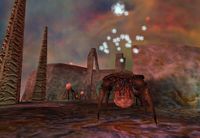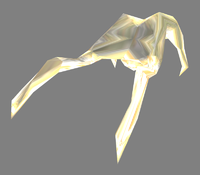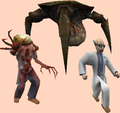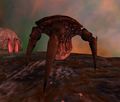Gonarch
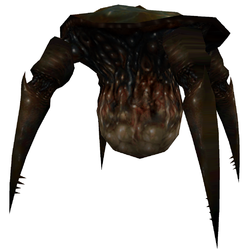
| |
| Gonarch | |
|---|---|
| General information | |
| Faction |
Xen wildlife |
| Type |
Headcrab breeder |
| Personal information | |
| Health |
2100/3150/4200 |
| Attack(s) |
|
| Game information | |
| Entity |
monster_bigmomma |
| Designer(s) |
|
The Gonarch is the final life phase of the Headcrab[1] introduced in Half-Life. Acting as the penultimate boss of the game, it is encountered in Xen during the chapter Gonarch's Lair.
Contents
Overview[edit]
The Gonarch's form is composed of a smooth, dark brown carapace supported by four powerful arthropod-like legs and a large fleshy, gelatinous egg sac that dangles from its underbelly. Little is known about how and when the metamorphosis from a Headcrab to a Gonarch takes place as few Headcrabs ever reach this stage.[1] Gordon Freeman enters the creature's lair and defeats it shortly after his excursion into Xen.
Behavior and skills[edit]
The Gonarch is almost completely invulnerable to damage, being heavily protected by a hard, crab-like outer shell. The large pendulous sac that hangs below its thorax is its only weak point. From afar, the creature spews out white globs of harmful chemicals from the top of its carapace in a mortar-like fashion, its Headcrab spawn also being immune to the acid.[3] At close range, it uses its front legs to swipe at its foe, dealing massive amounts of damage.
When in sight of an intruder, the Gonarch rapidly produces baby Headcrabs in great numbers from its sac, birthing them in pairs.[3] These babies are not very dangerous on their own but are extremely fast and can swarm attackers in groups, distracting them from their mother. There can be up to 20 simultaneous live baby Headcrabs at any given moment.[3] During combat, the Gonarch produces loud elephant-like whining cries. It emits low-pitched mournful groans whenever one of its baby Headcrabs is killed. Upon death, the Gonarch's egg sac violently bursts open, destroying itself and its nearby surroundings and releasing a large final brood of offspring in the process.
Despite its massive size, the Gonarch is capable of delicately maneuvering across the thin webbing that stretches across pits in its lair with ease, whereas both Gordon and its own Headcrab children simply fall through. The Xen Trees dotted around its lair deliberately avoid attacking it, although they will still stab at any Headcrabs that land in front of them.[4]
Behind the scenes[edit]
Valve CEO Gabe Newell recounted that the concept for the Gonarch emerged from an idle brainstorming session when someone at the company posed the idea, "Why don't we put a giant testicle on a 20-foot-tall armored spider?" Strong art direction and clear goals were set for the creature from the start, but the AI proved to be very complicated due to its immense size and how different it behaved from the more standard game monsters.[1]
According to Ted Backman, the Gonarch's design was a strongly contested around Valve's office at the time, some considering it to be too graphic. However, Gabe Newell championed the concept, greatly influencing its inclusion in the final product.[1] The creature's appearance seen in early concept art survived through development without any major changes. The Gonarch was nicknamed "Big Momma" or "Big Mama" by Valve,[1] featuring this title in the game's earliest previews,[5] These names are used internally in the game files, with the creature's model and entity being called big_mom.mdl and monster_bigmomma respectively. The final "Gonarch" designation is a portmanteau of the words "gonad", referring to the male reproductive organ, and "monarch", meaning leader. Its hanging egg sac was once given the humorous moniker "The Package" by Newell.[6]
The naming convention of the maps suggests that the Gonarch was meant to be fought later on during the Xen chapters just prior to fighting the Nihilanth.[a] Its boss battle takes place over three stages using custom info_bigmomma nodes to navigate around its arenas, only capable of being damaged during certain phases between nodes. When it arrives at its destination, it engages in combat with the player until it takes enough damage for it to begin traveling to its next proscribed node.
Some of the Gonarch's animations were not fully implemented. An unused defend sequence (using a placeholder duplicate of its angry1 animation) is assigned the ACT_GUARD AI activity, indicating it was meant to be used while protecting its young. Its fall1 and fall2 animations, meant to be used when the creature leaps down twice into the caverns, remain unused as well, instead being replaced in both instances by the generic jump sequence, also a duplicate angry1 placeholder animation. As the Gonarch is scripted to play the longer falldeath animation upon its death, the standard death animation cannot normally be seen in-game.
In the early stages of Half-Life 2's development, the Gonarch was slated to return in the form of the Combine Big Momma Pod, a Combine device utilizing an amputated Gonarch's egg sac to spawn Headcrabs that would have been encountered in Ravenholm.[7][8] This pod was cut in the final game, excising any references to the Gonarch in the sequel.
Gallery[edit]
The Gonarch producing baby Headcrabs depicted in Gary's mural.
List of appearances[edit]
Main games[edit]
- Half-Life (First appearance)
- Half-Life: Alyx (Mural only)
Other[edit]
Notes[edit]
- ↑ The opening Xen chapter takes place in the map
c4a1. The map names for the ensuing Gonarch's Lair chapter begin withc4a2. However, the maps in the subsequent Interloper chapter begin withc4a1a, sequentially following the initial Xen level.
References[edit]
- ↑ 1.0 1.1 1.2 1.3 1.4 1.5 Half-Life 2: Raising the Bar, page 14
- ↑ Yatsze Mark's personal website (archived)
- ↑ 3.0 3.1 3.2 Half-Life SDK,
bigmomma.cpp - ↑ Half-Life SDK,
xen.cpp - ↑ InterAction Magazine (Summer 1997 issue)
- ↑ 1999 Game Dive Interview
- ↑ Half-Life 2 leak
- ↑ WC map pack
